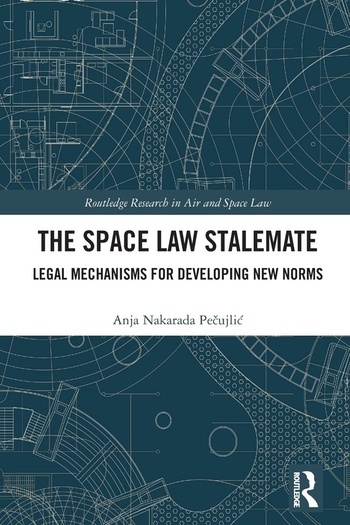Review: The Space Law Stalemateby Jeff Foust
|
| Activities in either scope or scale not foreseen in the 1960s, when the Outer Space Treaty was written, are emerging even as the legal mechanisms for dealing with them seem increasingly bogged down. |
There are two problems with the argument. One is that it’s not clear how real this spaceport project is: there’s little evidence that the project has the funding and expertise needed to build a launch facility, or that there’s real interest by China in launching from there given the logistical difficulties and limited advantages it offers (it is closer to the Equator, but there are overflight obstacles for launches to anything other than near-equatorial inclinations.) The other problem is legal: space law experts noted after the essay was published that China would be considered a “launching state” and bound by the Outer Space Treaty even if its rockets launched from Djibouti. In other words, the legal loophole claimed in the essay doesn’t exist.
It does though, illustrate some of the stresses on the current international space law regime that has not been updated in decades. Activities in either scope or scale not foreseen in the 1960s, when the Outer Space Treaty was written, are emerging even as the legal mechanisms for dealing with them seem increasingly bogged down. That is the challenge that Anja Nakarada Pečujlić on in the new book The Space Law Stalemate.
She succinctly argues that the systems set up to develop treaties and related binding law in the early Space Age no longer work well. That includes the UN’s Committee on the Peaceful Uses of Outer Space (COPUOS), which works by consensus. That is increasingly difficult to achieve when COPUOS now has more than 100 member states; at the time the Outer Space Treaty was developed, there were fewer than 30. (Consensus also breaks down when even a single country becomes a bad actor, as Russia has become at COPUOS and other international fora like the UN working group for reducing space threats.)
Pečujlić looks to other fields for alternative models. Much of the relatively slender book examines other organizations and systems for dealing with shared resources, such as the International Telecommnuication Union (ITU), which regulates radio spectrum, and the International Civil Aviation Organization (ICAO), which handles aviation. She also examines the mechanisms of the Law of the Sea treaty as well as multinational organizations like the European Space Agency and the European Union’s space office.
She offers several recommendations for freeing the current legal logjam. One is to simply replace the existing consensus model at COPUOS with a hybrid where majority voting is used in cases where consensus cannot be reached, although the book does not go into details about how that approach would work. A second approach would be to turn COPUOS into a UN “specialized agency” like the ITU and ICAO that would give it more power, and responsibility, to shape space law. More far-reaching, if unlikely, alternatives include establishing an international space agency or an organization that would provide “judicial review” for space legal measures.
| There are no easy or fast solutions (especially fast) to legal issues in space, but as the book shows, there are alternatives to the current system that is straining to keep up with current pace of space activities. |
One option curiously overlooked in the book is an approach that the United States and other nations are taking with the Artemis Accords. Nearly two dozen countries have signed the agreement that is intended to set norms for responsible behavior in space exploration, largely building upon the Outer Space Treaty. It was developed far more rapidly than anything that might come out of COPUOS (which spent the better part of a decade on a series of relatively basic, non-binding guidelines for long-term space sustainability) and has attracted support from both established and emerging space players. The Accords are not legally binding, yet do have some power: if you want to participate in Artemis, you’ll need to sign on. Over time, these may create widely accepted norms that can be codified into something more legally binding.
There are no easy or fast solutions (especially fast) to legal issues in space, but as the book shows, there are alternatives to the current system that is straining to keep up with current pace of space activities. Chinese launches from a notional spaceport in Djibouti may not evade the Outer Space Treaty, but other activities, from space resource utilization to active debris removal, do pose issues that may require updates to space legal regimes on timescales measured in years, not decades.
Note: we are using a new commenting system, which may require you to create a new account.
